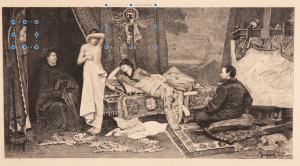There are many objects not immediately noticed in the piece of artwork, Debut in the Studio. Through an examination of this work, and a couple of poems read in class, I have come to see the way in which male dominance was accepted as a cultural normality during the Victorian Era. A man’s desire of a nice, virginal woman is suggested in this etching. A couple of objects in the work resemble angels. Angels generally represent purity, they can represent the dead, and they can represent holiness and faith. When looking at the etching, I noticed that at the top left there is what appears to be a doll hanging from the curtains (I’m not actually sure what this is supposed to really be). This doll is a stark white color which reiterates much of what we have talked about in class about the symbolism of this bright, however, quite eerie, color.
I see another angel towards the middle of the picture though looking at the picture in a literal sense, one sees that this purported angel is actually just the curtains and the tie that holds them together. Christina Rossetti’s poem, “In an Artist’s Studio” relates greatly to this piece of artwork. The word angel is included in this poem; Rossetti writes, “A saint, an angel — every canvas means / The same one meaning, neither more or less.” Earlier in the poem the author writes, “One face looks out from all of his canvases.” In the etching, one can see that the focal point is the half clothed woman who is in the middle of the left side of the work. Everyone is looking at her, including the male artist. When one examines the man’s sketch though, he or she sees that a different woman is drawn. The ‘one face’ that Rossetti has written about is collective, it is woman’s face. There is significance in the fact that the artist is looking at one woman while drawing another, even though, both of these women look strangely similar. Their cherubic faces and shockingly white skin exemplify all that a woman of the Victorian Era should be. The angelic features make them desirable character’s in this man’s story. By creating an image where the man is focusing on two very similar-looking women, it is as if he is lusting over their similar features. These attributes are the women’s purity, and heavenly bodies. The man focuses more on those rather than the distinguishable traits that make each woman herself. This man allows himself, whether he realizes it or not, to see the woman as less than human thus asserting and displaying the control he (and other males in the Victorian era) have, and has over females.
A second observation of this work that demonstrates man’s great power over women is shown through the placement of subjects in the artwork. Despite there being five women (including the angels) and only one man, the man has the whole right side of the work for himself and his sketch. The man has so much space all for himself, while the women are cramped! The power that these men believe that they posses is further displayed in Robert Browning’s poem “My Last Duchess.” In this poem the main subject, a man takes control over his now former wife by hiding a picture of her behind a curtain. He is the one who draws the curtain, but only when he pleases. Browning writes, “ […] since none puts by / The curtain I have drawn for you, but I […]” The man has control over who sees the painting of his wife, and the man in the etching has control over what he wants his women to look like as he is the artist (although I’m not sure that the women in this work can get any more white and similar-looking than they already are.)
Both poems and this artwork demonstrate the interesting gender power dynamics of this era. The fact that none of these works blatantly tells readers or viewers that men are in charge, shows that that role a man has, one of power, is just accepted. No one is repudiating the assumptions that these poems, and this etching are making.
Ramus, Edmond. “Debut in the Studio.” Trout Gallery, http://www.troutgallery.org/

You aptly compare women to angels/cherubs. Historically in Europe, they have been portrayed as pure, bright, androgynous beings (although that hasn’t always been the case; they were originally meant to be terrifying). I believe that male Victorian artists were trying to capture the surreal in their art, whether they were sacred or secular depictions. In trying to articulate their lack of understanding of the opposite sex, men objectify them, transform them into an ideal, yet static, presence. Women like the (literally) radiant one in this piece “control” the thoughts and desires of men as a result of their beauty. Men demonstrate their power (forgive me for the generalizations) in showing their “powerlessness,” if that makes any sense at all. I don’t know.